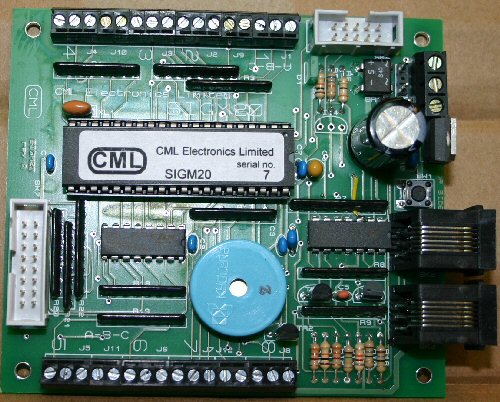
SIGM20 Automated Signal Controller

Please be advised that there is currently a two week lead time for dispatch of this product.
Product Description
The SIGM20 is an automatic controller for eight signals. It sets the signal state automatically according to the state of the trackwork (e.g. points), other signals and block occupancy detectors. It does this automatically, without any other computers involved: so no PC is required to operate the railway. The board can control simple blocks, simple and complex junctions ... automatically.
The SIGM20 drives LED signals directly. Via optional adapters it drives incandescent lamp signals or semaphore signals controlled by Tortoise point motors. The behaviour for each signal is programmed: thereafter it operates automatically without needing a PC to be present on the layout.
Controls up to 8 signals:
- The SIGM20 drives either eight, 3-aspect signals or six, 4-aspect signals
- Two more signals can be driven by an optional self assembly add-on board.
- LED signals: these can be 2, 3 or 4 aspect, or "searchlight" type.
- Incandescent lamp signals can be driven using optional adapters
- Semaphore signals operated by Tortoise motors can be driven using optional adapters
- Simulation of "soft" lighting & dimming of lights: brightness ramps up or down over approximately half a second for more realistic looking signal lamps.
Signals can be of two basic types:
- controlling a straightforward block (with one "ahead" route).
- controlling a diverging junction (where the route depends on the state of points on the section ahead).
Automatic signal logic, controlled in response to DCC and LocoNet activity:
- The signals go red when the block ahead of them is occupied - sensed by LocoNet messages from block detectors (e.g. BDL168)
- Signals will be amber if the next signal ahead is red
- Signals go red if the trackwork is set against them (e.g. if a point is not set correctly)
- Track can be set for running in both directions; signal state is then sensitive to the running direction active at the time
- Running direction can be set automatically by train movements, or by operator control
- .....and many other functions.
Fully compatible with the older SIGM10 - the two can be mixed on a layout seamlessly
- Screw terminal connections to signals
- All the logic to make this happen is entered through a simple PC user interface
- All the behaviour is determined by LocoNet & DCC messages.


